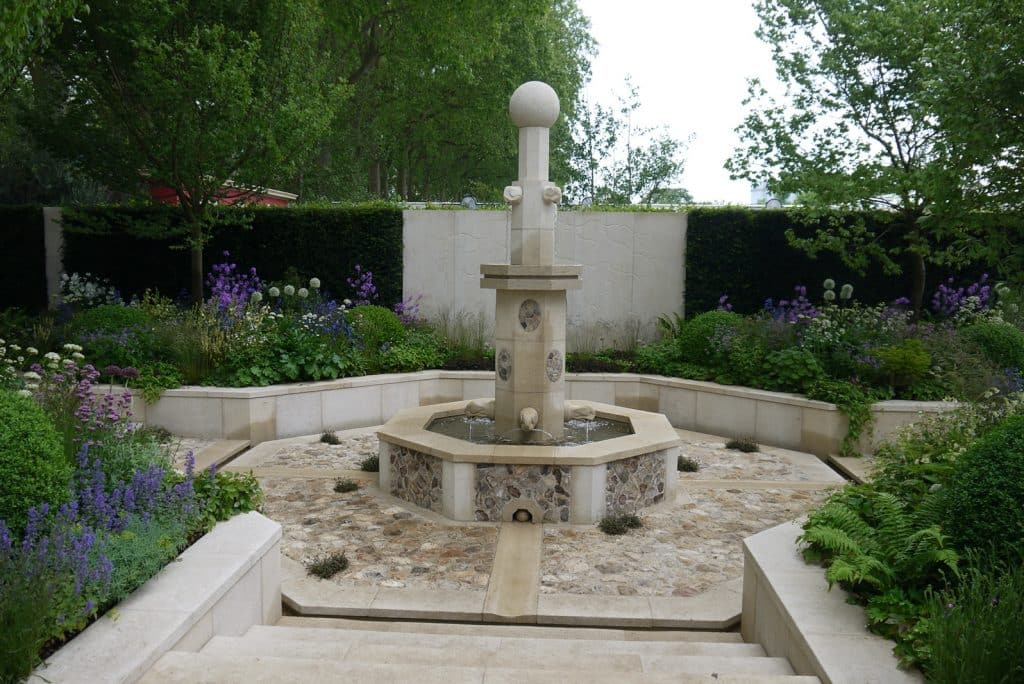Garden Focal Points
PRINCIPLES OF FOCAL POINTS
Whether it’s a contemporary London garden or a countryside estate that I am designing, the principles of design come into play in both. How, where, and what focal points I place in a garden are part of those principles. As a garden designer, how do I lead the visitor through that space, how do I create that journey, how do I guide them to a destination, where do I want to slow that journey down and where do I want them to focus? I do this by using focal points in a garden. Focal points allow me to control the way people move through a garden and how they view it.
The white wall faces the kitchen windows. Imagine how dull and lifeless it would look when you were looking out of the kitchen. By putting the decorative yellow panels, it makes a statement that can be viewed from the kitchen but also the seating area in this garden. It also draws attention to the outdoor kitchen area.

Designer Credit: Manoj Malde
Photo Credit: Paul Debois and Gardener’s World Magazine
HISTORY
Since the origins of gardening which stems to around 3,000BC, focal points in gardens have been a key principle to a well-designed garden. They were one of many ways that royalty, aristocracy, and the rich showed their wealth. The ancient Romans and Greeks used statues and urns. In the east, the Moghul gardens incorporated water features and richly carved Havelis (gazebos). The Taj Mahal is a perfect example. The arched main gateway deliberately makes the visitor focus on the fountains along the length of the water feature that leads your eyes to the monumental marble structure that simply takes your breath away. It is the mausoleum of Shah Jahan’s queen that is the focal point. During the Renaissance period, the Italian and French gardens adopted these principles.
In Britain, although the English Landscape Movement was a reaction against the Renaissance and the Baroque period, focal points continued to be a key element of garden design. These are seen in the gardens of many National Trust and English Heritage gardens. To this day garden, designers use focal points to draw and direct the eye within the space.
Designer Cleve West created this beautiful garden at the Chelsea Flower Show 2014 sponsored by M&G. A contemporary take on a classic Paradise Garden invented by the Persians. The skilful stonework of this central water feature creates a focal point within the garden that also provides a sensory experience with a calm and contemplative space.

Design Credit: Cleve West Photo Credit: Manoj Malde
WHY USE FOCAL POINTS
What is the purpose of using focal points in a garden? Apart from drawing the eye and creating a journey, focal points can
. help the designer to harness the property into the landscape, thereby creating unity between home and garden
. the designer can capture the client’s character in the garden
. focal points can create drama and theatre in a space
. they can be used as elements of surprise in a garden
. focal points can also transform a pretty planting border into an absolutely wow spectacle
. they can bring personality into a garden
. focal points can also create human responses by stirring up emotions or becoming part of the sensory experience
. they can help to create sweet spaces where the eye can rest in the landscape before journeying onto another area
. the focus can be removed off an unsightly view by camouflaging with a focal point.
This moon gate combined with the cast iron gate makes a great focal point that not only draws your attention to the planting in the front but then leads your eye though the gate, down the gravel pathway to the destination beyond. It is a window that creates a journey and makes you want to explore the other areas through the gate.

Photo Credit: Manoj Malde
WHAT TO USE AS FOCAL POINTS
Take your pick. The wonderful thing about focal points is that they can be whatever you want to use. They can be either a showpiece or be practical.
. a specimen plant that has beautiful form and structure
. a sculpture or statue that can become a conversation piece in the garden
. a stunning water feature created from a glazed pot or a corten trough. This can also create a sensory experience in the garden
. large containers in clay or metal are suitable for the outdoors. Powder-coated or grp containers can provide a vibrant pop of colour.
. furniture can also be used as focal points. How about a beautifully sculpted bench by Tom Raffield, some colourful tolix chairs around a table or even a love seat
. a firepit or even a fireplace to create a warm, cosy seating area for those chilly evening
. a louvered pergola, a timber-framed one that is covered in roses or scented climbers or an
Arbour walkway that is covered in fairy lights.
. if you are blessed with a beautiful view in the distance, how about borrowing from the landscape and making it part of your garden by framing it. It could be a church steeple that can be seen through a window cut through a hedge or framed by a moon gate.
Here, at Broughton House, a simple terracotta pot is used a focal point, placed at a point where the gravel path changes direction.

Photo Credit: Manoj Mald
When it comes to choices for focal points the world is your oyster. There are no hard and fast rules or formulas. One thing to bear in mind with focal points is that less is more. In a small garden, use too many and they can look like clutter. A small garden will most likely only need one focal point. In a large garden, dependent on size, you can use more. Make sure that whatever type of focal point you use that it works with the look of the surrounding landscape. Putting something very contemporary into a cottage-style garden may jar.
At Sandhill Farm in Hampshire Rosemary Alexander has placed this this blue chair at the end of the pathway framed by the yew hedge. As you walk past the other end of the path it catches your eye and makes you want to venture down the path and explore the garden on the other side. The chair can also be viewed from the house.

Photo Credit: Manoj Malde
PLACEMENT OF FOCAL POINTS
Garden designers use the lines of the property as axes. What is the line of sight as you look out of the windows and doors? You may want to position a focal point so that it can be viewed from a few different positions both indoors and outdoors. When designing a garden, it is worth looking at where your focal points are going to be at the start of the process. This way the focal point becomes part of the whole scheme and does not look like an afterthought.
The idea of focal points is to draw attention to a particular area and create a reason for the viewer to journey to that destination and stop. This can be anywhere within a landscape. Some popular places for focal points are
. the front of the house. You may want to make a statement of the front door by positioning plants either side of the front door. It makes the entrance more welcoming.
. a carriage drive may have a specimen tree or fountain
. at the end of the garden or pathway
. where two points cross. This is often seen in Islamic gardens where there is a central water feature where two paths cross.
. where there is a change in direction.
However, these are not the only places where focal points can be. A pond can make a great place for a piece of sculpture that looks as if it is floating on the water, and you see the reflection on the surface. A dull wall or fence can be lifted with some laser-cut panels. Sculptures can look mesmerising when they are placed in a meadow or a prairie, especially when they get lit by the low winter sun.
Focal Points can also be about practicality. Here at Hidcote, this structure not only acts as a focal point and provides a window to the view beyond, but it cleverly provides a place to sit, and shelter should the heavens open.

Photo Credit: Manoj Malde
PLANTS AS FOCAL POINTS
Specimen plants can be quite breathtaking. Look at the shape and form of the plant. I have used a Japanese cloud tree at the very end of a client’s garden. The view is framed by a slatted trellis on either side that sits forward allowing the shed to be hidden behind.
When using plants as a focal point it is important to choose something that will give you a long season of interest. There is no point in using something that will look amazing for two to three weeks and then nothing for the rest of the year. If you are thinking about a tree, look for an interesting branch structure, is the trunk gnarled or twisted, does it produce flowers, is there scent, does the bark peel or have a distinct pattern, what is the autumn colour like.
If you have a green backdrop such as a hedge, you do not want to be plant something as a focal point that will be green most of the year. Think about creating a wall or screen of colour that will enhance your focal point.
COLOUR
Colour is a very powerful tool. Look at how so many brands use colour to create a visual identity and draw attention. Use colour in the same way in your garden. Look at the overall colour palette of your garden and then the planting colours. Then think about a colour that is not seen anywhere in the space but could work well to enhance the visual experience of your garden. Imagine the main palette of your garden being purple, yellow, white, and green. Now drop in some pink plant pots. They can be positioned three in a line or dotted through the garden, making the eye move along and creating a journey to a destination.
Another option could be a painted wall creating a backdrop to a seating area. Maybe a bistro table and chairs powder coated in orange. All these options will draw the eye. Make sure they are positioned to get visual impact from inside the house.
Now that you know a little about focal points and how they can bring life into a garden, have some fun with them.

Design and Photo Credit: Patrick Collins Landscapes
I adore the way designer Patrick Collins has used these bright red pots as focal points in this communal space. The strong pop of colour brings this space alive and adds the wow factor. Three pots have been positioned in the space which makes the eye travel through the sinuous path but every pot acts as an exclamation mark where the eye can rest before moving on.



